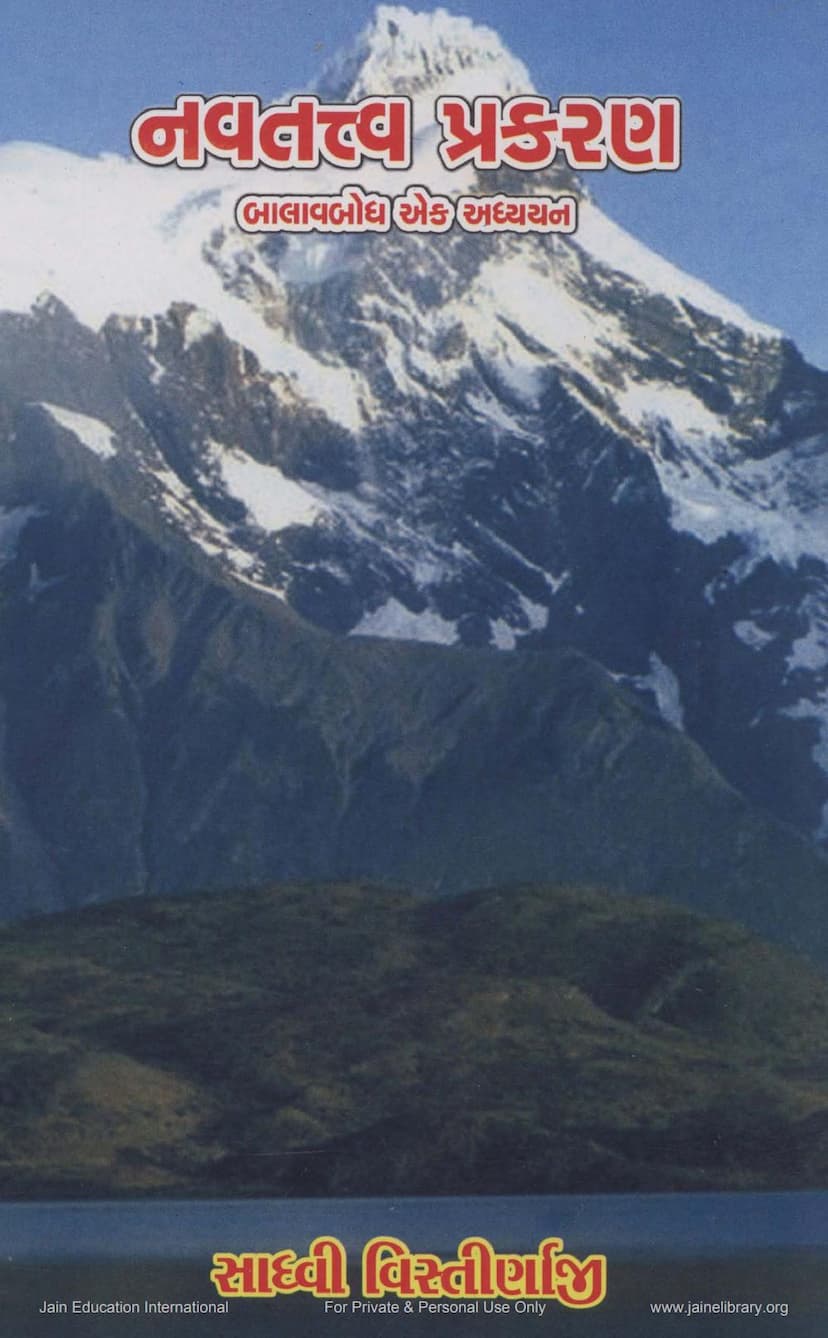Navtattva Prakarana
Added to library: September 2, 2025

Summary
Here is a comprehensive summary of the Jain text "Navtattva Prakarana Balavbodh" by Vistirnashreeji, based on the provided pages:
Book Title: Navtattva Prakarana Balavbodh Author: Sadhavi Vistirnashreeji Mahasatiji (M.A., Ph.D.) Publisher: Shri Jaybhikkhu Sahitya Trust Catalog Link: https://jainqq.org/explore/004936/1
Overall Purpose and Context:
The book "Navtattva Prakaran Balavbodh" is a detailed academic study and explanation of the fundamental Jain principles known as the "Navtattva" (Nine Realities). Authored by Sadhavi Vistirnashreeji, a scholar with M.A. and Ph.D. degrees, the work aims to make these core Jain teachings accessible and understandable to a wider audience, particularly to lay followers ("Balavbodh" implies understanding for the young or beginners). The text is based on a critical edition and analysis of an ancient, unpublished manuscript titled "Harshavardhanaganikrut Navtattva Prakaran Balavbodh" (composed around the 15th century).
Key Themes and Content:
-
The Importance of Navtattva: The Navtattva are presented as the lifeblood and foundational essence of Jain philosophy. They are described as essential for spiritual liberation, forming the core of Jain teachings on self, reality, karma, and the path to salvation. Understanding these principles is deemed as crucial as air and water for human life.
-
Academic Approach and Scholarly Recognition: Sadhavi Vistirnashreeji's work is a result of extensive research, culminating in a Ph.D. thesis. The book received recognition from the university, acknowledging the author's deep scholarship and effort in making complex philosophical concepts accessible. Several distinguished scholars and religious figures have provided commendatory forewords, highlighting the significance and quality of her contribution to Jain literature and studies.
-
The Manuscript and its Author: The primary focus of the research is an ancient manuscript of "Navtattva Prakaran Balavbodh" attributed to Harshavardhanagani. Little is known about Harshavardhanagani himself, but based on available evidence, he is believed to be a disciple of Acharya Somasundarsuri, a prominent figure from the Tapagachchha lineage. The research involved analyzing multiple manuscripts to establish a reliable text.
-
The Nature of Jain Philosophy: The text emphasizes that Jainism offers a unique perspective on reality, moving away from divine grace and rituals, and focusing on personal responsibility for one's destiny through actions and karma. The Navtattva provide a detailed framework for understanding concepts like soul (Jiva), non-soul (Ajiva), virtue (Punya), vice (Papa), influx of karma (Asrava), stoppage of karma (Samvara), shedding of karma (Nirjara), bondage (Bandha), and liberation (Moksha).
-
Linguistic and Stylistic Analysis: A significant portion of the study is dedicated to analyzing the language and prose style of the 15th-century Gujarati manuscript. The author examines the grammar, vocabulary, use of Sanskrit and Prakrit words, and rhetorical devices employed by Harshavardhanagani. The "Balavbodh" style is noted for its clarity, use of examples, and simplification of complex ideas to aid understanding. The text also highlights the linguistic evolution from Apabhramsha to Old Gujarati.
-
Detailed Exposition of Each Tattva:
- Jivatattva (Soul): Explained as the essence of consciousness, knowledge, and the experiencer of karmic results. The text delves into the fourteen types of Jivas based on their number of senses and stages of spiritual development (Gunasthana).
- Ajivatattva (Non-soul): Discusses the five types of non-soul substances: Dharma (medium of motion), Adharma (medium of rest), Akasha (space), Kala (time), and Pudgala (matter). It elaborates on the characteristics of Pudgala, its various forms (Skandha, Desa, Pradesha, Paramāṇu), and the subtle classifications of matter.
- Punya and Papa (Virtue and Vice): Detailed lists of karmic influxes leading to virtue (resulting in happiness and favorable rebirths) and vice (resulting in suffering and unfavorable rebirths) are provided, including the types of karmas and their effects.
- Asrava (Influx of Karma): The causes of karmic influx are thoroughly explained, categorized into five main types: senses (Indriyas), passions (Kashayas), vows (Avratas), mental/vocal/physical activities (Yogas), and actions (Kriyas). Twenty-five types of actions contributing to karma are listed.
- Samvara (Stoppage of Karma): The means to halt the influx of karma are detailed, including five Samitis (careful activities), three Guptis (restraints), twenty-two Parikshas (endurance tests), ten Yati-dharmas (virtues of an ascetic), twelve Bhavanas (meditations), and five Charitras (conducts).
- Nirjara (Shedding of Karma): The process of shedding accumulated karma is explained through twelve types of austerities (Tapas), categorized into external (Bahya) and internal (Abhyantara) austerities.
- Bandha (Bondage): The four aspects of karmic bondage are discussed: Prakriti (type of karma), Sthiti (duration), Anubhaga (intensity of fruition), and Pradesha (quantity). The eight principal karmas and their specific causes and effects are elaborated.
- Moksha (Liberation): The ultimate goal of Jainism, described as the soul's pure, liberated state, free from all karmic bondage. The text outlines the means to achieve Moksha: right faith (Samyakdarshan), right knowledge (Samyakgnan), right conduct (Samyakcharitra), and right penance (Samyaktap). It also discusses the state of liberated souls.
-
Manuscript Analysis and Philology: The research includes a critical analysis of four key manuscripts used for the edition. It details their origin, approximate dating, condition, script, and unique features. The philological section meticulously examines the language, grammar, and vocabulary, providing detailed explanations of archaic words, verb forms, case endings, and the use of Sanskrit-derived terms within the Gujarati prose. This linguistic analysis is crucial for understanding the historical context and the author's scholarly approach.
-
Detailed Glossary and Bibliography: The book includes extensive appendices: a glossary of technical terms, an index of citations from scriptures, and a comprehensive bibliography of Jain literature, particularly handwritten manuscripts related to Navtattva. This provides valuable resources for further study.
Significance:
"Navtattva Prakaran Balavbodh" by Sadhavi Vistirnashreeji is a significant scholarly contribution that bridges the gap between ancient Jain texts and modern understanding. It not only elucidates the profound philosophical concepts of the Navtattva but also showcases meticulous textual criticism and linguistic analysis, making it an invaluable resource for scholars, students, and anyone seeking to deepen their knowledge of Jainism. The author's dedication to making these essential teachings accessible underscores the text's importance for spiritual aspirants.